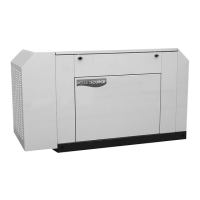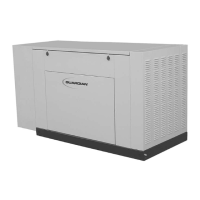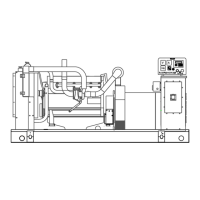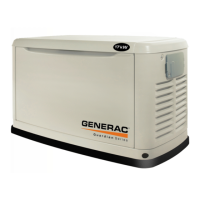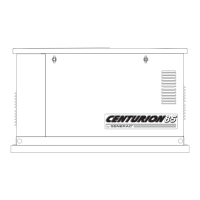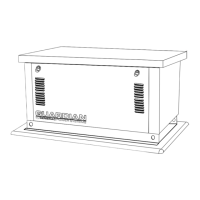
Do you have a question about the Generac Power Systems NP-40G Series and is the answer not in the manual?
| Fuel Type | Natural Gas / Propane |
|---|---|
| AC Output Power (Propane) | 40 kW |
| Voltage | 120/240V |
| Frequency | 60 Hz |
| Engine | Generac 2.4L |
| Weight | 1800 lb (816 kg) |
| Sound Level | 67 dBA at 7 meters at 50% Load |
Critical safety precautions and warnings for generator operation and manual use.
Guidance on manual usage, assumptions about user knowledge, and safety disclaimers.
Principles of magnetism in electricity generation.
Discusses electromagnetic induction and its role in generator operation.
Explains how electric current creates magnetic fields and their behavior.
Describes the nature of alternating current and its waveform.
Defines and explains the units of electrical measurement: Volt, Ampere, and Ohm.
Overview of major generator components and their relation to the diagram.
Description of the upper fan housing and its function.
Details about the permanent magnet rotor and its assembly.
Explains the rotor hub and its connection to the rotor and assembly.
Describes the stator assembly, its construction, and electrical output.
Explains the stator adapter and its attachment to the engine.
Details the lower fan and flywheel and their assembly.
Describes the engine as a single cylinder, overhead valve unit.
Explains the stepper motor's function in controlling engine speed.
Discusses the Genistor's role as a frequency converter.
Explains the functions and operation of the CCG circuit board.
Describes the overall operational flow of the generator system.
Explains the generator's operational logic and control functions.
Discusses how dirt and moisture affect insulation resistance.
Describes types of testers used for insulation resistance.
Information about stator leads and their testing.
Steps for preparing to perform insulation resistance tests.
Procedure for testing stator windings to ground.
Procedure for testing stator windings for shorts.
Methods for cleaning insulation before testing.
Methods for drying the generator to ensure proper insulation.
Overview of component testing procedures.
Procedures for testing the stator assembly.
Procedures for testing power windings.
Procedures for testing the timing winding.
Procedures for testing power supply windings.
Procedure for testing components for a short-to-ground condition.
Procedures for testing the Genistor.
Procedures for testing the battery charge circuit.
Describes common symptoms of CCG circuit board failures.
Procedures for testing the CCG circuit board.
Describes the construction of the control panel and its mounting.
General information about sheet metal parts and their purpose.
Diagram showing the exploded view of sheet metal components.
Overview of the engine used in the generator.
Explains the principles of a 4-cycle engine.
Description of the intake stroke in a 4-cycle engine.
Description of the compression stroke in a 4-cycle engine.
Description of the power stroke in a 4-cycle engine.
Description of the exhaust stroke in a 4-cycle engine.
Explains valve timing and ignition timing.
Information on recommended fuels for the generator.
Guidance on selecting and using engine oil.
Procedures for storing the generator.
Steps for performing an engine tuneup.
Lists and illustrates the main components of the valve train.
Procedures for removing valve train components.
Details related to the piston within the valve train context.
Procedures for servicing valves and valve seats.
Details on valve seats, guides, and their specifications.
Information on valve margin and valve spring specifications.
Procedures for installing valve train components.
Procedure for tightening cylinder head bolts.
Steps for adjusting valve clearance.
Procedure for installing the rocker arm cover.
Information on oversize pistons and rings and their fitment.
Steps to take before removing pistons and connecting rods.
Procedures for removing the piston.
Detailed information about the piston.
Specifications for piston minor diameter.
Specifications for piston major diameter.
Procedures for checking piston rings.
Specifications for ring to groove clearance.
Procedures for checking piston rings end gap.
Details on the connecting rod and its assembly.
Procedures for assembling and installing components.
Procedures for servicing the cylinder bore.
General overview of crankshaft and camshaft.
Procedures for removing the crankcase cover.
Procedures for removing the camshaft.
Procedures for inspecting the camshaft.
Procedures for removing the crankshaft.
Procedures for inspecting the crankshaft.
Details on the crankshaft sleeve bearing.
Procedures for installing the crankshaft.
Procedures for installing the camshaft.
Details on the compression release mechanism.
General overview of the gaseous fuel system.
Lists and describes gaseous fuel system components.
Information on interconnecting lines in the fuel system.
Key considerations for gaseous fuel systems.
Information on the excess flow valve in gaseous systems.
Discussion on gaseous carburetion.
Procedures for testing gaseous fuel lines for leaks.
Description of the air cleaner assembly.
Description of the air intake system.
Procedures for servicing the air cleaner.
Description of the fuel filter.
Description of the electric fuel pump.
Procedures for testing the fuel filter.
Procedures for testing the fuel pump.
General information about the carburetor.
Procedures for disassembling the carburetor.
Explanation of carburetor operation modes.
Procedures for adjusting the carburetor.
How engine speed is controlled via the CCG system.
Procedures for adjusting throttle linkage.
General information about the automatic choke.
Detailed description of the automatic choke's function.
Explanation of how the automatic choke operates.
Procedures for checking and adjusting the automatic choke.
Steps for pre-choke adjustment.
Procedures for adjusting the choke solenoid.
General information about the speed control system.
Explains the CCG board's role in speed control.
Explains the stepper motor's role in speed control.
Common problems related to the stepper motor.
Information on throttle linkage and its importance.
Procedures for testing the stepper motor.
General overview of the gaseous fuel system.
Lists and describes gaseous fuel system components.
Information on interconnecting lines in the fuel system.
Key considerations for gaseous fuel systems.
Information on the excess flow valve in gaseous systems.
Discussion on gaseous carburetion.
Procedures for testing gaseous fuel lines for leaks.
General information about shutoff valves and regulators.
Description of the LP gas regulator.
Procedures for testing the fuel lockoff solenoid.
General information about the LP gas carburetor.
Procedures for adjusting the carburetor.
Procedures for removing the carburetor.
Information on carburetor disassembly and reassembly.
Overview of the engine oil system and its components.
Explanation of how oil flows through the system.
Description and inspection of the oil pickup screen.
Description and inspection of the oil pump.
Description and inspection of the pressure relief valve.
Description and inspection of crankshaft oil seals.
Description and inspection of the breather assembly.
Description and inspection of the oil sump.
General overview of the engine cooling system.
Explains airflow into the generator compartment.
How to compensate for airflow restrictions.
General overview of the engine DC control system.
Explanation of how the engine operates within the DC control system.
Procedures for priming the system.
Explanation of the cranking operation.
Explanation of the running operation.
Explanation of the normal shutdown procedure.
Information on engine protective devices.
Description of Receptacle J1 and its functions.
Description of Receptacle J2 and its functions.
Details on circuit board connections.
Overview of the engine cranking system.
Lists the components of the engine cranking system.
Recommendations for the battery used in the system.
Procedures for connecting battery cables.
Procedures for testing the battery's condition.
Information on testing the starter-run-stop switch.
Information on testing the starter contactor.
Overview of the engine ignition system.
Description and placement of the ignition cage assembly.
Description of the ignition module.
Description of the ignition sensor.
Description of the ignition coil.
Information on spark plugs and their gap.
Procedures for testing the ignition system.
Overview of engine protective devices.
Description and testing of the oil pressure switch.
Description and testing of the oil temperature switch.
General information about the optional remote panel.
Information on remote panel cables.
Description of the Model 9043 remote panel.
Description of the Model 9042 remote panel.
Details on wiring connections for the remote panel.
A chart outlining troubleshooting steps for generator and speed control issues.
Introduction to troubleshooting the engine DC control system.
Troubleshooting steps for priming function failures.
Troubleshooting steps for engine crank failures.
Troubleshooting steps for engines that crank but do not start.
Troubleshooting steps for engines that start hard or run rough.
Troubleshooting steps for engines that start and then shut down.
Detailed specifications for different generator models.
Table of nominal resistances for generator windings.
Detailed engine specifications for GN-190 and GN-220 models.
Torque specifications for various engine components.
Table of engine speeds and corresponding voltages under load.
